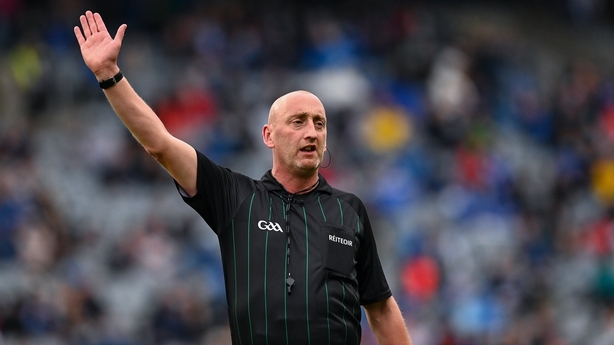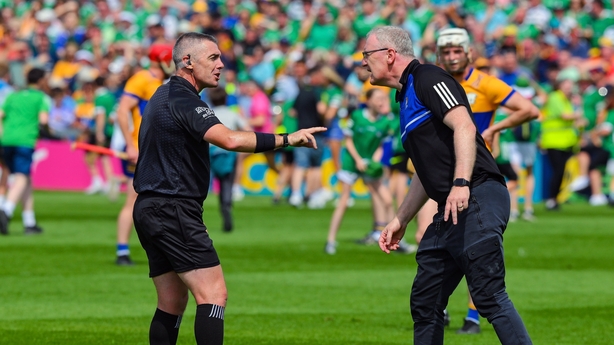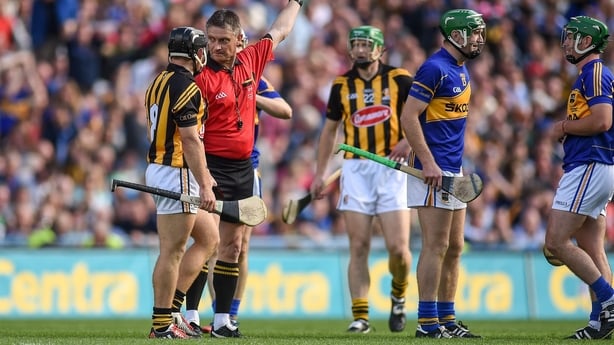Taking your opportunities from dead balls is crucial in hurling.
One of the many reasons Kilkenny and Limerick will line out in tomorrow's All-Ireland decider is the accuracy of their free-takers.
In the Cats’ semi-final victory over Clare, almost half of their scores (12/26) came from TJ Reid placed balls.
The all-time record championship scorer missed just 1 of 11 shots from frees or 65s, also cutting over a sideline.
By contrast, Clare raised eight of their 23 flags from dead balls and missed three, two by Mark Rodgers and one for Tony Kelly.
Galway’s Evan Niland only missed one in their defeat to the Treaty, for whom Aaron Gillane was flawless (5/5). Diarmaid Byrnes was off target from two of his five long-range efforts however.
Accuracy also cost the Banner in the Munster final, when Kelly and first-choice free-taker Aidan McCarthy – who went off injured – missed two each in a game Clare lost by a single point. Gillane had a 100% record (8/8).
Kilkenny have a slight advantage if it comes down to a free-taking contest: Reid’s accuracy is 85% for the year compared to 83% for Gillane and 58% for Byrnes, who will take on anything from his own 45 and has scored 0-14 from placed balls. Goalkeeper Eoin Murphy occasionally does the same for Kilkenny and got a point against Antrim.
But if the Cats are relying on placed balls to keep them in the game tomorrow then they better get them on the board early.
In the vast majority of championship games this year, referees awarded more frees in the first half (70%) compared to more in the second (20%) or the same in each (10%). Those games where more frees came in the second all involved a big lead and the losers getting frustrated or winners fouling to prevent clear goal chances.
The average amount of frees awarded drops from 13.2 in the first 35 minutes to 12.5 in the second. That is despite more additional time typically being played in second halves, due to substitutions.
Niland dispatched all seven of Galway’s share of the 13 James Owens signalled in the first half against Limerick but that dropped to five each in the second period.
The Sunday Game analyst Shane Dowling remarked at half-time that "in the early stages of the game you couldn’t tickle someone and James Owens was giving a free. In the last 10 minutes, you couldn’t buy a free. It’s one way or the other. But the last 10 minutes has certainly suited Limerick more".
This trend was even more noticeable in last year’s final, when Colm Lyons awarded 14 first-half frees (nine to Kilkenny, with top-scorer Reid converting 7/7) and only seven in the second half, when Gillane and Byrnes both went 2/2.

So are referees swallowing the whistle, consciously or otherwise, as the game goes on? Four-time All-Ireland final referee Barry Kelly thinks there are other factors at play.
"Referees like to establish what’s going to be allowed or what’s not going to be allowed early on," he tells RTÉ Sport. "John [Keenan] will be no different. Especially in his first final.
"Players will always push it, and they’ll push it early on, for 10 or 15 minutes, so the referee wants to assert their authority and let them know who is in charge. Providing the players are on-board, you will feel you have control and then you can probably afford to loosen the reins a small bit as the game goes on.
"There’s also an element of players being more nervous, clumsy and careless early on in a game. Early on, they might be more focused on making a statement to their man-marker but in the second half maybe you’re more focused on the bigger picture.
"They’ll be taking that bit more care. In the first five minutes, if you give away a free or a jersey pull it doesn’t tend to be that punitive, you have time to get it back. I doubt you’ll see a lad doing that in the last three minutes on Sunday because you don’t want to be responsible for your county losing.
"I’d be surprised if there were more than 22, 23 frees in total. I think it will be a close game and sometimes they are easier to referee because they focus on the ball the whole time."

Kelly also discounts the possibility of referee fatigue – "the top lads in football and hurling are so fit" but does accept that the man in black might need more persuading as the seconds tick down.
Ref Liam Gordon was criticised for not awarding Clare a free in the closing stages of that one-point Munster final.
"Liam was unlucky with the pitch invasion [just beforehand]. I’d say that flummoxed him a bit," suggests Kelly.
"You would really want to be sure that it’s a genuine free to bring a game level or to win a game. Up to maybe 65 minutes, I think every free is on its merits. You’re not as conscious that it could be a game-defining free.
"If it’s a very tight game, in the last few minutes, you still referee it as normal but you are conscious that a free now could be [pivotal] and it might be a bit more difficult to win frees.
"There’s an element too of not wanting to be seen to be playing for a draw, which referees in the GAA have regularly been criticised of. Though that’s less likely now with the injury-time having to be declared."
Kelly awarded a memorable late free himself, in the drawn 2014 All-Ireland final between Tipperary and Kilkenny.
With 11 seconds remaining in normal time, and just one additional to come, he adjudged Brian Hogan to have charged Padraic Maher, about 50 metres out from the Tipperary goal. Hawk-Eye was needed to confirm John 'Bubbles' O’Dwyer had sent the last puck of the game a sliotar’s width wide of the posts.

Would he still give it today?
"That's a good question! Players are pucking the ball even further since then. A free from their own 45 will probably be nailed on Sunday if there’s no breeze.
"When I gave it I was probably thinking that it might land 10 or 15 metres out from the goals. I might have lost my bearings a little. But if it’s a free, it’s a free, the onus is more on the players."
Limerick are perceived to be the hardest tacklers in the game and do tend to concede more frees than the opposition, thereby also benefitting more from the second-half drop-off. The free count in the second halves of their championship games this year dropped from an average of 14.16 to 11.5, in comparison with 13.75 to 12.5 for matches involving the Cats. Though there is an argument that more of Limerick’s second halves were closer contests.
Speaking after his unfortunate season-ending injury in the Munster final, Limerick captain Declan Hannon suggested that players don't adapt their tackling mid-contest.
"If they blow for a handpass early on, maybe you’re thinking ‘they’re going to pull this all day’, or for steps, things like that," he told RTÉ Sport.
"But if we were worried about what you can or can’t do in terms of tackling or what the refs are going to do, we’d kind of forget about the game altogether and just be worrying about the ref. Players have enough going on with trying to get on the ball and do what they want to do with the ball instead of worrying if they’re going to be pulled.
"It wouldn’t necessarily get into your head. It’s funny, when you’re playing you wouldn’t know how many frees are being given for or against you. You’re just getting ready for the next ball, it comes so quickly. Our mantra has always been ‘Get on with it’, if the free is given against you that’s fine just move onto the next ball."
The teams that foul more usually win in hurling; Kilkenny's victory over Clare earlier this month and the Limerick-Galway semi-final in 2022 being notable exceptions.
"Managers are probably willing to take the hit of giving away one or two frees," suggests Kelly. "Because it means that your work-rate is up at that level.
"It will be very physical on Sunday. They are two very physically strong teams. Both teams will feel that if they are more ferocious it will be a key factor in winning the game."
Especially when thrown handpasses, steps, and free-arm tackling are harder to see and rarely punished.
"The game has changed so much," says Kelly. "Now you have more swarm-tackling.
"Five or six years ago, you probably had more one-on-one physical battles. If two players are going for a ball and one is fouling the other, it tends to be fairly obvious.
"It’s probably harder to spot individual fouls now, because there are three or four lads around a player. That’s not a foul but if one or two are holding them by an arm it’s difficult to spot. Teams know that.
"If five or six players are contesting a ball, it’s also hard to pinpoint who made the first foul, which is key. If two lads from opposite teams foul almost simultaneously, you tend to let that go, to be fair. You’re hoping the ball moves from that zone and plays opens up.
"I’d say you’d be very unlikely to see any hand-passes blown in the second half, unless it’s an incredibly obvious throw. There could be easily one or two blown early on. Just so the referee gets control and establishes to the players what will be tolerated."
Keenan didn’t referee another game in last year’s championship after perceived laxity in the extra-time epic Munster final between Limerick and Clare. Two Clare players, Peter Dugan and Rory Hayes, had suspensions proposed in the aftermath but escaped sanction on a technicality.
The Wicklow man had awarded an above average number of frees, however, and more in the second half of normal time (16 v 15). He did likewise in the Galway-Tipperary quarter-final this year (17 v 15). Perhaps the whistle won’t be swallowed at Croke Park after all?
"John’s style tends to be that he lets a bit go," says Kelly. "But I think he’ll strike a balance. It’s his last game, unless they change the age range of referees [under 50], so he’s not going to be a maverick and let it all go loose. He’ll want to do a good job."
Additional stats: Jonathan Bradley
Watch the All-Ireland Hurling Championship final, Limerick v Kilkenny, this Sunday from 2.30pm on RTÉ2 and RTÉ Player, follow a live blog on RTÉ.ie/Sport and the RTÉ News app or listen to live commentary on Sunday Sport on RTÉ Radio


